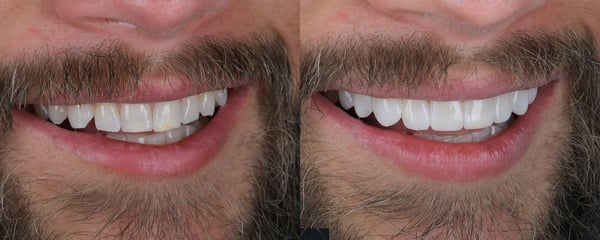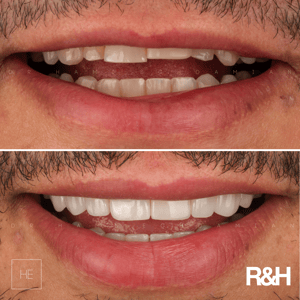Achieve a perfect smile, and smile confidently again, with composite veneers in Marbella
What is Composite Bonding?
Composite bonding (aka composite veneers) is a dental procedure in which a tooth-coloured resin material is applied to the surface of a tooth, sculpted into shape, hardened, and polished to improve the appearance of the tooth. It is also called tooth bonding or dental bonding. The resin material used in composite bonding is a mixture of glass or quartz filler particles and a resin medium that is used to hold the filler particles together. Composite bonding in Marbella is often used to repair chips or cracks in teeth, to close gaps between teeth, or to change the shape or color of teeth. It can be an effective and less expensive alternative to porcelain veneers. The procedure is typically quick and can be performed in one visit, once the planning phase is done.

Steps Involved in Composite Bonding
1. Consultation Appointment
- Purpose: To assess your teeth and discuss your goals.
- What Happens:
- Initial Assessment: The dentist examines your teeth and gums to ensure you're a suitable candidate for composite bonding.
- Photos and X-rays: High-quality images of your teeth are taken to evaluate alignment, colour, and structure.
- Discussion: Your dentist will discuss your desired outcome, review colour-matching options, and address any concerns.
- Treatment Plan: A personalised plan is created, and costs are explained.
2. Preparation Appointment (if necessary)
(Only required in certain cases, such as pre-treatment whitening or minor adjustments.)
- Purpose: To prepare your teeth for bonding by enhancing aesthetics or addressing underlying issues.
- What Happens:
- Tooth Whitening (optional): If you're whitening your teeth, this is done before the bonding to match the composite to the final tooth shade.
- Minor Adjustments: Any necessary smoothing or shaping is done if teeth need levelling.
3. Composite Bonding Appointment
- Purpose: To apply and sculpt the composite resin to achieve the desired result.
- What Happens:
- Tooth Preparation:
- Teeth are cleaned thoroughly.
- A mild acidic gel is applied to the surface of the teeth to roughen them slightly, improving bonding.
- Bonding Process:
- The dentist applies a bonding agent to help the composite resin adhere to your teeth.
- Layers of tooth-coloured resin are applied, shaped, and sculpted to achieve the desired look.
- Curing:
- Each layer of resin is hardened using a special blue light.
- Polishing:
- The bonded teeth are smoothed and polished for a natural finish, ensuring they match the texture and shine of your other teeth.
- Tooth Preparation:
4. Follow-Up Appointment (optional)
- Purpose: To ensure you're happy with the results and make any adjustments if needed.
- What Happens:
- Review: Your dentist checks the bonding for durability and comfort.
- Polishing (if required): Any additional smoothing or touch-ups can be done.



Composite Bonding Vs. Porcelain Veneers
Composite bonding and porcelain veneers are both dental procedures that can be used to improve the appearance of teeth, but they have some differences.
Composite bonding is a procedure in which a tooth-colored resin material is applied to the surface of a tooth, sculpted into shape, hardened, and polished to improve the appearance of the tooth. It can be used to repair chips or cracks in teeth, to close gaps between teeth, or to change the shape or color of teeth. Composite bonding is typically less expensive than porcelain veneers and can be performed in one visit to the dentist's office. However, the resin material used in composite bonding is not as durable as porcelain and may not last as long. It is also more prone to staining and may require touch-ups or replacement over time.
Porcelain veneers are thin shells of porcelain that are custom-made to fit over the front surface of a tooth. They are used to improve the appearance of teeth that are chipped, worn, discolored, or misaligned. Porcelain veneers are more durable and resistant to staining than composite bonding, but they are also more expensive. The procedure for placing porcelain veneers typically requires two visits to the dentist's office, with the first visit being used to prepare the tooth and take impressions for the veneers, and the second visit being used to place the veneers.
Which procedure is better for you will depend on your specific needs and budget. Your dentist at R&H DENTAL will be able to advise you on the best option for you based on the condition of your teeth and your desired results.



Frequently Asked Questions about Composite Bonding in Marbella
Do you have to shave down any of my teeth?
Usually not all, as long as your teeth are relatively aligned, and you don't have one that is sticking way out of the arch.
If this is the case, then with a little minor short-term orthodontics (or Invisalign), we can simply pushing that tooth back into the arch and do no-shave (aka no-prep) composite veneers.
How does dental composite bonding differ from veneers?
Dental composite bonding involves applying a resin directly to the tooth's surface, while veneers are thin shells that cover the front of the tooth. Bonding is a less invasive option.
Is dental composite bonding suitable for fixing chipped teeth?
Yes, dental composite bonding is an excellent option for repairing chipped or cracked teeth, restoring them to their natural appearance.
What are the advantages of dental composite bonding?
Dental composite bonding is a quick, cost-effective, and minimally invasive way to improve the appearance of teeth, often requiring just one visit to the dentist.
Can dental composite bonding be used to close gaps between teeth?
Yes, dental composite bonding can be used to close small gaps or spaces between teeth, providing a more uniform and aesthetically pleasing smile.
Is dental composite bonding a permanent solution?
Dental composite bonding is durable but may need touch-ups or replacement over time. It typically lasts several years with proper care.
How long does a dental composite bonding procedure take?
The duration of a dental composite bonding procedure in our R&H Dental Clinic depends on the extent of the work but usually takes about 30 minutes to an hour per tooth.
Is dental composite bonding painful?
No, dental composite bonding is typically painless. Most patients do not require anesthesia unless the bonding is used to repair a cavity.
Can dental composite bonding stain or discolor over time?
While dental composite bonding in is resistant to staining, it can discolor slightly over time. Avoiding tobacco, coffee, and dark-colored foods can help maintain its appearance.
Who is a good candidate for dental composite bonding?
Dental composite bonding is suitable for individuals with minor cosmetic dental concerns like chips, gaps, or tooth discoloration.
Request a Composite Bonding consult Appointment

Price range
295-395€ per tooth, depending on patients needs and expectations, and the complexity of the case (for particularly difficult cases the price might be more and you will be informed of this amount after your first free consultation).
Wax up and design, if needed, charged separately. If the injection-mould technique is used, the lab-made mould is also charged separately.



